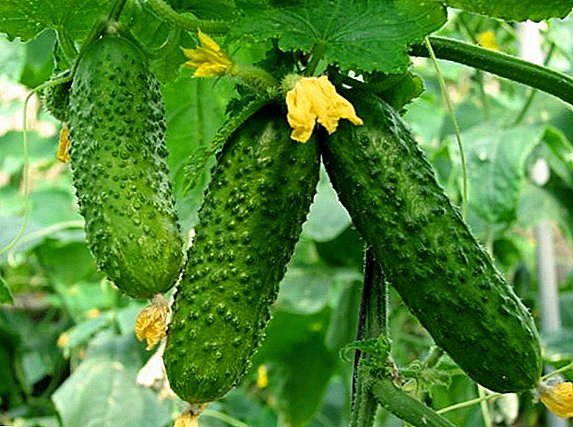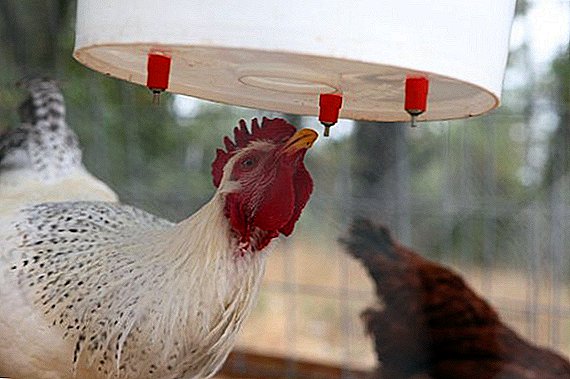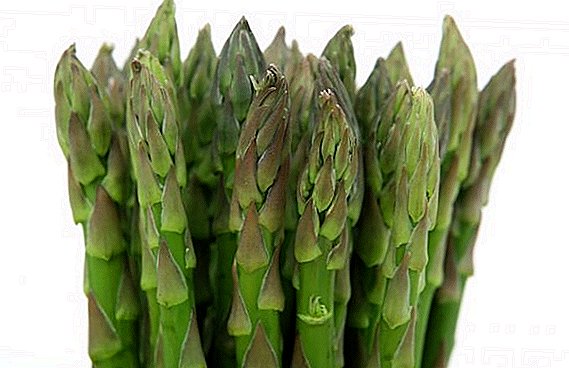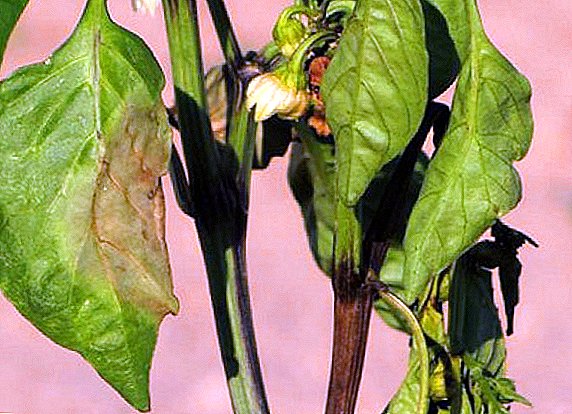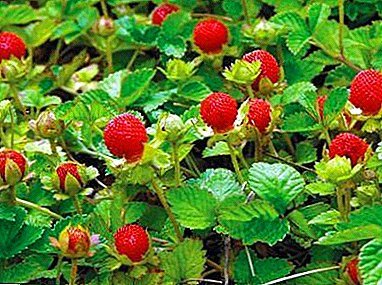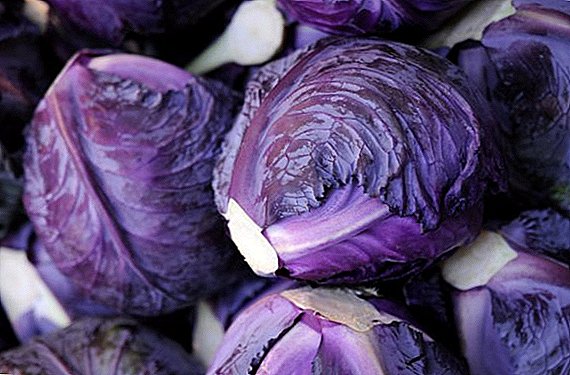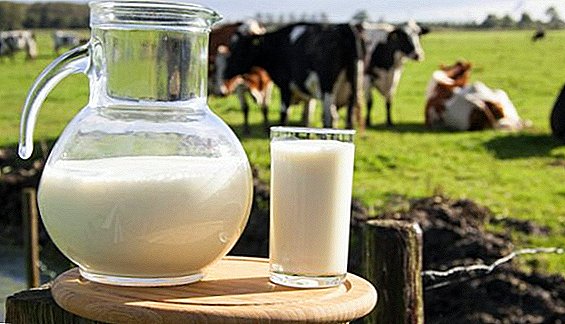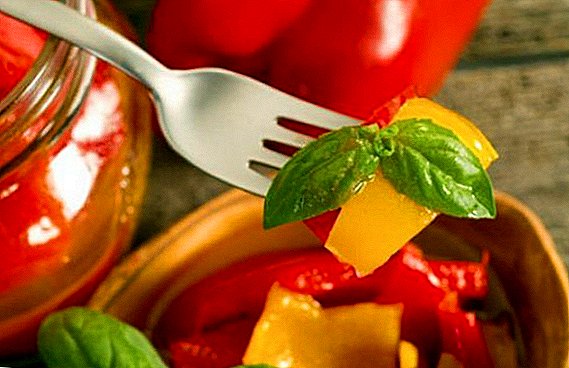 A well-prepared Bulgarian pepper will not only decorate any table, but will also rightfully take the place of honor of the most delicious hit. It is his many cooks consider fertile material to create masterpieces of dishes. So let's figure out how to prepare this vegetable for the winter, to get quickly and tasty.
A well-prepared Bulgarian pepper will not only decorate any table, but will also rightfully take the place of honor of the most delicious hit. It is his many cooks consider fertile material to create masterpieces of dishes. So let's figure out how to prepare this vegetable for the winter, to get quickly and tasty.
Marinated pepper and its taste
A characteristic feature of pickled vegetables is the preservation of color and shape, as well as an unforgettable savory taste. Moreover, the preparation of marinades does not take much time and requires very few ingredients.
Did you know? In ancient times, some types of pepper equated to gold. For example, in antiquity, black pepper often served as a tribute. To save his people from the incessant attacks of the Huns, Ancient Rome gave their leader Attila more than a ton of spicy spices.
According to experts, such dishes preserve most of their nutrients, and therefore are ideal for vitamin supplementation of the body in the winter.  Marinated Bulgarian pepper can be used as a separate snack, or added to various salads. Such preservation in food tandem or separately will always be a source of juiciness and brightness. But, besides presentability, it will also please with excellent taste.
Marinated Bulgarian pepper can be used as a separate snack, or added to various salads. Such preservation in food tandem or separately will always be a source of juiciness and brightness. But, besides presentability, it will also please with excellent taste.
How to choose a pepper for pickling
To make pickled peppers look good in a jar and on a table, only high-quality products should be selected for harvesting. They should be:
- ripe
- whole;
- strong;
- with fleshy and juicy pulp;
- without spotting, mechanical damage and other flaws.
Experienced housewives are advised to prepare for the preservation of multi-colored variations of sweet pepper. Firstly, the colorful layers of the blank look very original in the jar, and secondly, under one lid you will have a whole artistic set for creating a culinary masterpiece.
Check out the most popular sweet pepper varieties: Antey, Anastasia, California Miracle, Gypsy F1 and Bogatyr.
Step by step recipe for pickled bell pepper
From all kinds of marinades, we chose the easiest, but very tasty recipe. Therefore, for the family, guests and loved ones a few jars will be small. However, try it yourself.
Kitchen tools
To prepare the marinade, we need:
- washed and sterilized banks (it is better to take a half-liter);
- metal covers;
- sealer key;
- a large enamel bowl or pan (for cooking);
- colander;
- wooden spatula (for stirring);
- kitchen knife;
- measuring cup;
- kitchen scales;
- ladle;
- tanks for washing and slicing pepper;
- a large wooden cutting board (needed to put hot cans);
- a terry towel and a quilt (for wrapping seaming).

Did you know? Hundreds of years ago, rich merchants called "bags of pepper." In those days, such a nickname was considered very prestigious, since it meant success and a stable income. Therefore, each merchant dreamed of hearing in his address exactly this phrase.
Ingredient list
To preserve tasty, it is important to strictly observe the dosage of all ingredients. Be careful: you have to weigh even garlic. For the marinade you need to measure the following ingredients:
- 1 kg of bell pepper;
- 30 grams of garlic;
- 200 ml of drinking water;
- 100 ml of table vinegar (9%);
- 100 grams of granulated sugar;
- 30 grams of rock salt;
- 40 g of sunflower oil.
Important! When stirring the sweet pepper, wipe the kitchen tools very carefully. Otherwise, the vegetable flesh will turn into a mess, losing its presentability.
Step by Step Cooking Process
Immediately warn that from 1 kg of pepper will be a small yield of the finished dish. Therefore, counting the proportion of all necessary ingredients, multiply all by at least 3.
So, we proceed:
- Clean the washed pepper from seeds and tails, cut into small slices and let it dry.
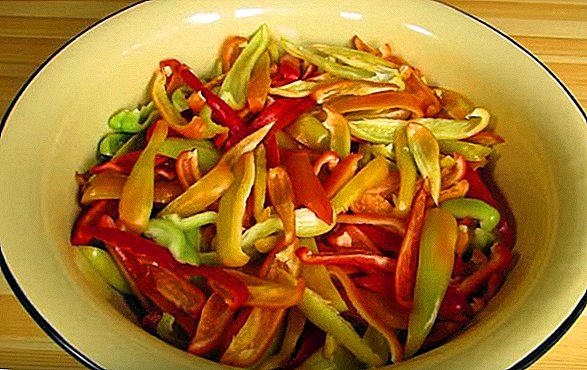
- Then dip the chopped vegetable in boiling water and blanch for about 3 minutes. If desired, this procedure can be slightly simplified: in this case, you just need to pour boiling water over the slices, mix it with a wooden spatula, cover with a lid and leave for 10 minutes.

- After the specified time, discard the pepper slices into a colander.
- Measure out the right amount of water (you can use the one that remained after pepper preparation) and bring it to a boil.
- In boiling water add chopped garlic and vegetable slices. Boil for 5-7 minutes while stirring.
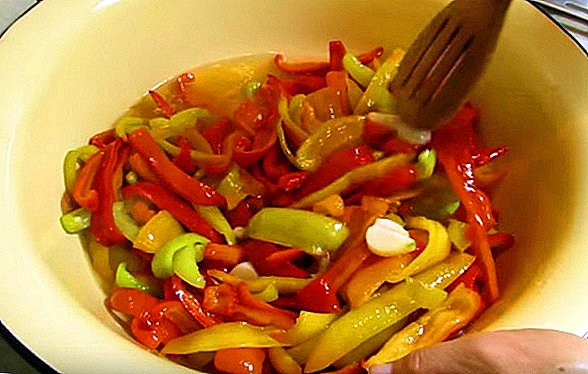
- 3 minutes before readiness add vinegar to the marinade, then immediately cover it with a lid. The liquid must boil. Make sure that the contents do not digest. His willingness will witness the softness and elasticity of pepper.
- Spread the pickled slices into the jars and cover with the marinade. Cover and roll up.
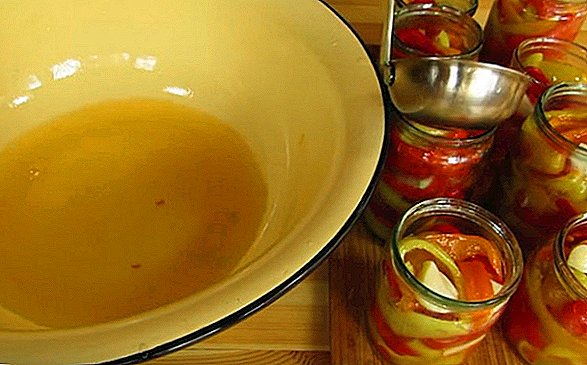
- Immediately turn the lid back down, wrap it well and let it cool.
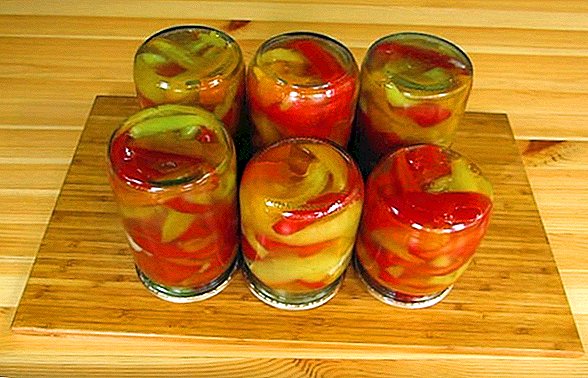
Important! To sterilize the cans is best to use the oven. First they are washed, then put in a cold oven and set the temperature at 120-130 ° C. The procedure ends when the container is completely dry.
Video: How to pickle Bulgarian pepper for the winter
Unusual blanks of pepper for the winter
If the classical recipes do not satisfy your taste preferences, we suggest to try extraordinary blanks. Surely your guests will be pleasantly surprised marinated pepper fried or baked.
We recommend reading about the methods and recipes for harvesting pepper for the winter.
Marinated Baked Peppers
For the preparation of one liter jars of this billet we will need:
- 2 kg of Bulgarian pepper (it is desirable to choose the most juicy specimens);
- 5 cloves of garlic;
- 1 teaspoon Italian herbs;
- half a teaspoon of ground pepper mix;
- 10 black peppercorns;
- 10 grains of coriander;
- 1 teaspoon of table salt;
- 1 teaspoon of vinegar (9%);
- 1 teaspoon granulated sugar (can be replaced with liquid honey);
- half a cup of sunflower oil.
 Wash the vegetables thoroughly and bake them in the oven. This procedure lasts about 15 minutes at a temperature of 200 ° C.
Wash the vegetables thoroughly and bake them in the oven. This procedure lasts about 15 minutes at a temperature of 200 ° C.Meanwhile, peel the garlic and pass it through a special press. Then put the obtained gruel into a deep bowl and add to it vegetable oil, salt, sugar, pepper mixture, Italian herbs, vinegar. All as it should mix to get a good marinade.
Did you know? The first surviving written records of pepper were made a thousand years before Christ. They are written in ancient Sanskrit in India. Accordingly, this country is considered the birthplace of all types of pepper.
By this time, you can already pull out the pepper from the oven. It needs to be cooled, then cleaned from the skin and seeds. The selected pulp immediately fold into a clean jar. It is not worth filling it up to the lid itself, because we still need a place for the marinade. Then they add pepper-peas and coriander. On top of the neck pour the previously prepared marinade.
The last step in the preparation of conservation is sterilization of the workpiece. To do this, jars of pepper should be placed in a pot of water (do not forget to pre-cover it with any cloth), cover with lids and cook for another 20 minutes after boiling. Then the banks are removed from the boiling water and roll covers. 
Marinated Roasted Peppers
This seaming can be done even in three-liter jars. It has a very mild and pleasant taste, so it does not linger long on the plate.
For cooking, take:
- 2 kg of bell pepper;
- 2 tbsp. spoons of sugar;
- 1 teaspoon salt;
- 3 tbsp. spoons of vinegar (9%);
- 4 cloves of garlic.
Important! The most common causes of spoilage of home canned food are poor-quality washing of vegetables, insufficient sterility of cans and loose rolling of the lids. Therefore, in the process of cooking with particular rigor, monitor the cleanliness of the containers and products with which you work, and also strictly adhere to the recipe and do not rush to finish the sterilization.
First wash the vegetables thoroughly and let them dry. In a sterilized jar sprinkle sugar, salt, vinegar and chopped garlic. Then put the boiling water on the fire and proceed to roasting the pepper.
To do this, pour a little oil on a cold frying pan and allow it to warm up a little. They lay out whole vegetables with tails and, covered with a lid, fry on both sides until golden brown.
Prepared pepper laid out in jars and pour boiling water. After that, the container can be rolled metal cap. Preservation must be turned upside down and wrap tightly with a blanket until it cools completely. 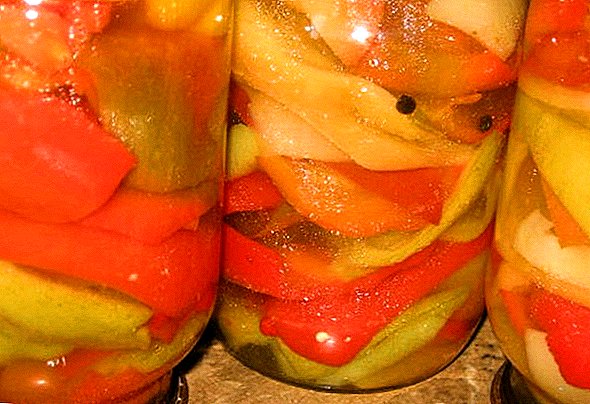
Pickled peppers with carrots
Snack is prepared from:
- 2 kg of bell pepper;
- 2-3 medium sized carrots;
- 8 teaspoons of vinegar (5%);
- 2 cloves of garlic;
- 2 bay leaves;
- greens (to taste);
- 2 liters of water;
- 8 teaspoons of granulated sugar;
- 8 teaspoons of rock salt.
Important! When cooking homemade marinades, avoid aluminum cookware. In an acidic environment, the material begins to interact with the contents of the container. As a result of a chemical reaction, not only the color and taste of the dish, but also its chemical composition deteriorates. Hazardous compounds appear among nutrients.
In the prepared jars at the bottom, they put garlic, laurel leaves and greens, passed through a press or chopped into petals. Then add vinegar and spread the vegetables. Now you can proceed to the preparation of the marinade. To do this, in an enamel saucepan with water, mix sugar and salt. Bring everything to a boil and pour the liquid into the jars.  At the final stage of conservation requires sterilization. If you use a half-liter container, this procedure will take about 8 minutes, but for liter cans it will take twice as long.
At the final stage of conservation requires sterilization. If you use a half-liter container, this procedure will take about 8 minutes, but for liter cans it will take twice as long.
We advise you to familiarize yourself with the methods of sterilization of cans at home.
Banks are pulled out of the water and sealed with lids in the traditional way.
Rules and features of storage of blanks
If in the process of harvesting conservation requirements were met regarding the purity of products and seaming containers, as well as the sealing of clogging, the banks can be stored at room temperature. However, such storage is shown only to those canned food that have been sterilized.  Better still, homework is stored in the cellar. It is important that there is good ventilation and no dampness. Otherwise, the metal covers very soon become unusable due to rust.
Better still, homework is stored in the cellar. It is important that there is good ventilation and no dampness. Otherwise, the metal covers very soon become unusable due to rust.
Important! It is impossible to leave conservation for a long time near a stove, a central heating battery or an oven. The fact is that when heated, even in a perfectly clean and sealed can, chemical processes will begin. Soon this will lead to molecular changes in sugar, darkening of the syrup and swelling of the lid.
In the small housing areas of some hostesses set seaming on the balcony. This method of storage requires constant monitoring of temperature. After all, in frosty weather, the billet will freeze, which will not in the best way affect its quality. And the bank can burst.
But even in the most suitable conditions, canned food can be stored for no more than a year. In the future, their chemical composition will significantly deteriorate. This will happen due to the constant chemical reactions that occur between the canned products and the lid material.
Possible difficulties
Even experienced housewives in the process of preparing home canning sometimes face difficulties. Often they appear a few days after preparation in the form of darkened marinade, swollen or blown-up lids.
Did you know? In fact, Bulgarian pepper has nothing to do with Bulgaria. Tracking the etymology of this name, linguists agree that the product, spreading throughout the world, came through Bulgaria, first to Poland, then to Ukraine and Russia.
To avoid this, use the following tips:
- Always sterilize cans for canning.
- Wash products thoroughly and blanch them if necessary. Special attention should be paid to hard-to-reach places. In Bulgarian pepper is a zone around the tail.
- Do not reduce intuitively the terms of the dish sterilization. If the recipe says 20 minutes - turn off the fire, only when the banks will stay in boiled water for a specified time. Very often, the hostesses make a fatal mistake at this stage: the time of sterilization is not counted from the moment water is boiled, but from the moment the fire is turned on.
- Carefully check the integrity of the rubber ring on the covers. This nuance is important for sealing can closure. Also note the condition of the covers. They should not be dents, cracks, punctures.
- For marinades do not use tin lacquered caps. Due to the interacting acids of the contents and the metal, chemical reactions occur, provoking the appearance of gas. Be careful, because in this case, the fill remains transparent and does not issue a product marriage. But the cap swells up.
- Some swollen marinades may be suitable for further use. Each case requires an individual approach. As a resuscitation for spoiled pickled vegetables, you can resort to subsequent washing with 2% brine and pouring with a new, stronger marinade.

What is the combination of pickled peppers on the table
Marinated bell pepper is considered a versatile dish for any occasion. It can be served with meat, fish, mashed potatoes, roast, vegetable stew. It is also an excellent material for making sandwiches, soups, homemade pizza.
Read also how to pickle: green tomatoes, zucchini, plums, mushrooms (chanterelles, wild mushrooms, milk mushrooms, ryadovki), watermelons and gooseberries.
Only desserts and sweets are not suitable for pickled dishes. And everything else can be combined.
That's all the secrets of delicious and beautiful preparations for the winter. The main thing - follow the recipe and do not neglect the helpful tips. Cooked marinades will delight you for a long time in the cold season.







